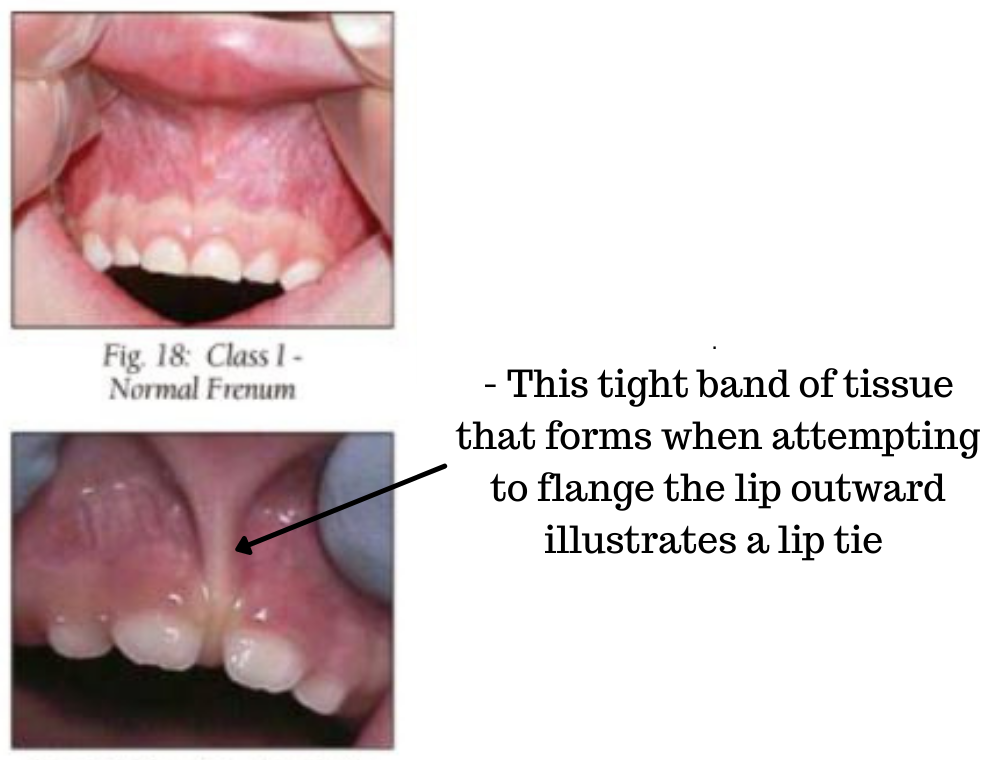What is a Lip Tie?
Revised lip tie in 2-week old infant
Tethered oral tissues, tongue ties, oral ties, lip ties…. What do all these terms mean? We touched upon tongue ties in a previous article, but now, we’d like to introduce and talk more about what a lip tie is.
What is a lip tie?
Use your fingers to lift your upper lip and try to touch your nose with this lip, see that little string of tissue holding your lip to your mouth? That is known as a lingual frenulum. In some people, this frenulum is very dense tissue that prevents the lip from flanging outward - this is a lip tie.
What are some symptoms of a lip tie?
In infants: A lip tie prevents the upper lip from flanging well and this causes an inability to have an effective seal at the breast or bottle. These babies swallow large amounts of air when feeding which results in colic, gas, and overall discomfort. Some nursing babies try to compensate for their poor latch and end up causing discomfort for nursing mothers and a clicking noise that can audibly be heard as the babies lose suction when nursing.
In toddlers: Due to the tight attachment of the upper lip, lip-tied toddlers tend to get cavities on their top front teeth. This occurs because food accumulates and it becomes very difficult to clean the top front teeth when the lip can’t flare outward properly.
In adults: Adults may have excess spacing between the front two teeth due to a lip tie. Despite having braces, that space may be difficult to eliminate unless the lip tie is treated.
Why are lip ties controversial?
Unfortunately, there are several reasons that lip ties have been deemed “controversial” by some medical providers:
Firstly, there is a great disconnect when diagnosing lip ties. In one study, different providers were shown photographs of different lingual frenulums (lip attachments) and they were asked to judge whether the children had a lip tie. The study found a mere 8% interrater reliability - which means that most providers rated the degrees of lip tie drastically differently.
As a pediatric dentist and lactation counselor, I follow Dr. Baxter’s guiding principle that the main diagnosis of a lip tie should not be appearance alone. “The lip-tie shape is highly variable, but the main factor is the impact on function.” Thus, regardless of appearance, if your little one is experiencing poor latch, excess gas, or clicking noises at the breast, it is vital to reach out to your lactation consultant and/or pediatric dentist.
A majority of the time, (close to 90% as reported by prominent ENT Dr. Ghaheri) lip ties and tongue ties occur at the same time in an individual. Thus, when a provider goes to treat the tongue tie, they often treat the lip tie as well. Due to this phenomenon, it is very difficult to discern exactly what impact the lip tie individually had.
How do you treat a lip tie?
A lip tie is often treated by an ENT or pediatric dentist. Laser or scissors are utilized to clip the excess tissue holding the lip in place. It is very important that the lip is stretched out several times a day after the procedure to ensure proper healing and a post-op check is performed in 1-2 weeks to ensure good wound healing.
What are the stretches necessary for proper healing post lip tie revision?
It is very important that as part of the post-operative healing process, the lip is stretched out 6x daily for the first 2-3 weeks and then stretches are gradually tapered off. Stretches involve placing a finger (ensure it is clean or gloved!) under the lip and moving the finger, in a sweeping motion, up as high as possible. This website provides a great visual example of the stretches.
+ References
Santa Maria, Chloe et al. “The Superior Labial Frenulum in Newborns: What Is Normal?.” Global pediatric health vol. 4 2333794X17718896. 12 Jul. 2017, doi:10.1177/2333794X17718896
“Chapter 3.” Tongue-Tied: How a Tiny String Under the Tongue Impacts Nursing, Feeding, Speech, and More, by Richard Baxter et al., Alabama Tongue-Tie Center, 2018, pp. 19–34.
Ghaheri, Bobby. “Tongue Tie and Lip Tie FAQ.” DrGhaheri.com, DrGhaheri.com, 2 Oct. 2014, www.drghaheri.com/blog/2014/10/2/tongue-tie-and-lip-tie-faq.
Image: Kotlow, Lawrence. (2003). Oral Diagnosis of Abnormal Frenum Attachments in Neonates and Infants: Evaluation and Treatment of the Maxillary and Lingual Frenum using the Erbium: YAG Laser. J Pediatr Dent Care. 10.



